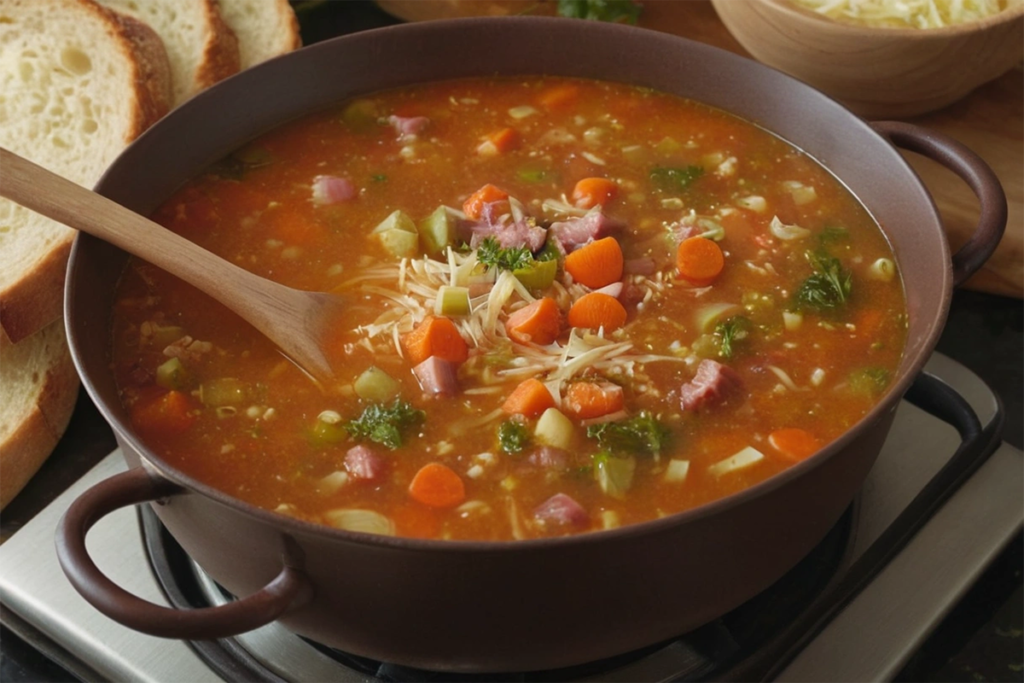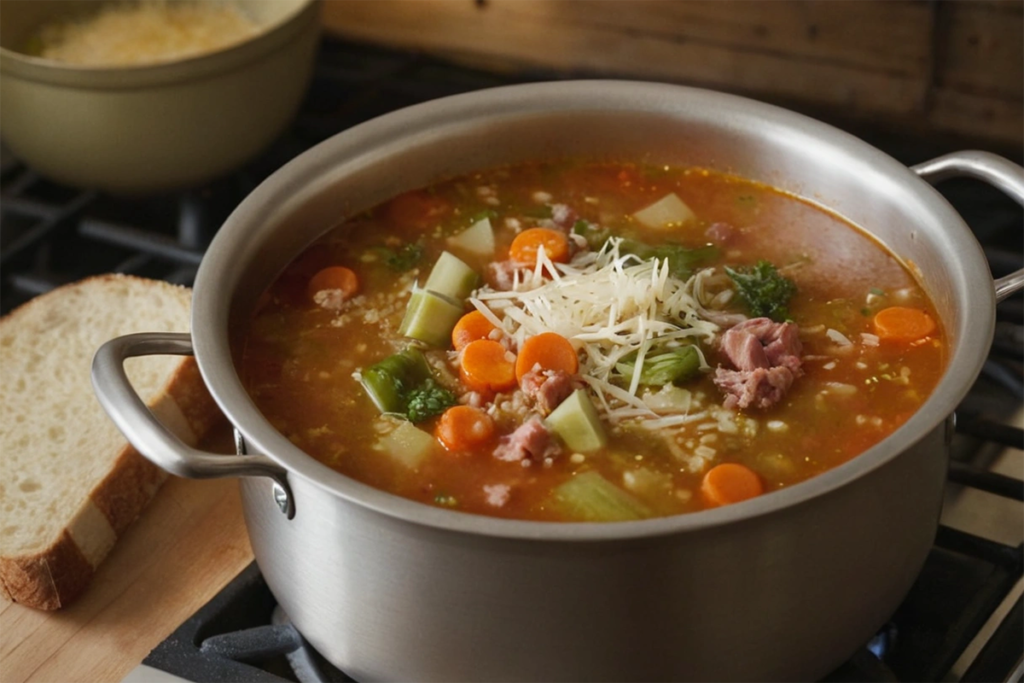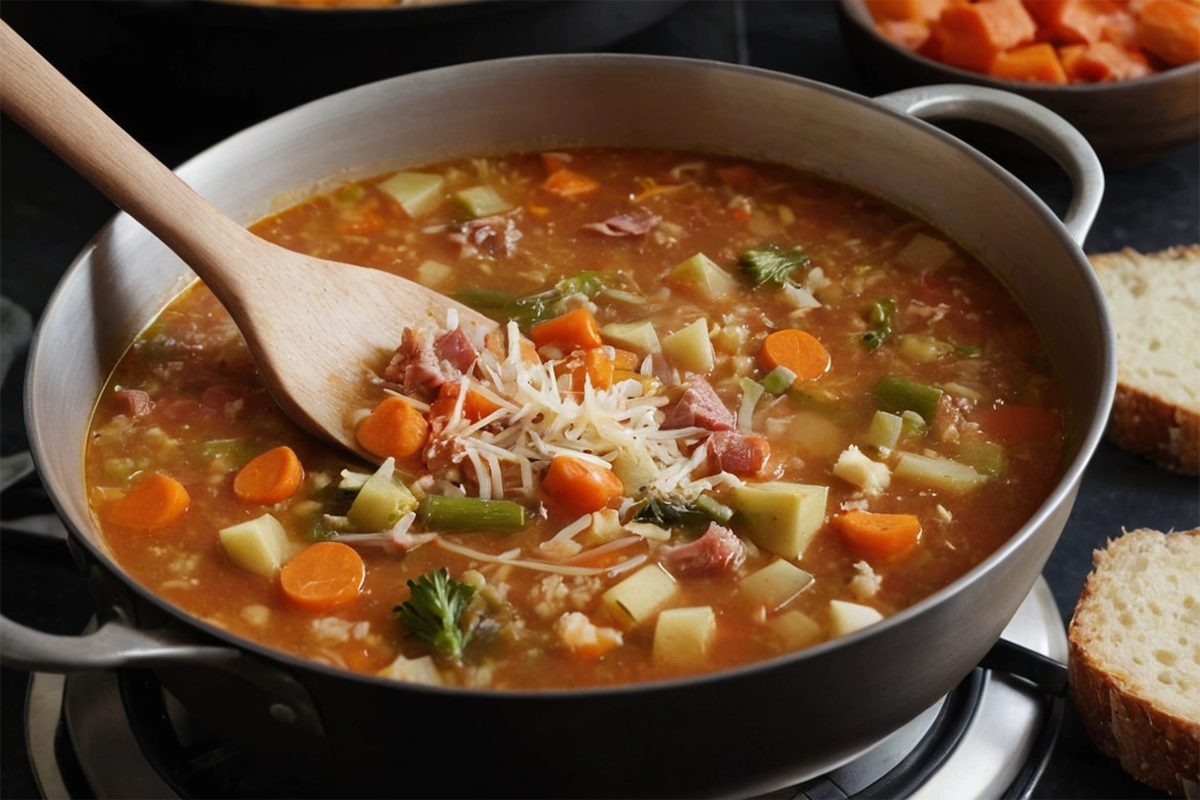Parmesan cheese is a versatile and flavor-packed ingredient used in a variety of dishes, from pastas to salads. But when it comes to soups, it serves a dual role: enhancing flavor while also contributing to the texture. Whether you’re making a creamy soup or a hearty broth, knowing which type of Parmesan to use can significantly elevate your dish. So, what Parmesan cheese is best for soup? Let’s explore the different types of Parmesan, how they affect soups, and tips for using them to get the best results.
Before diving into the details, check out Food Network’s guide on using Parmesan rinds in soup for an in-depth look at how this often-overlooked part of the cheese can boost your soups. If you’re also curious about Parmesan’s thickening properties, our guide on Does Parmesan Cheese Thicken Soup? provides detailed insights into how this cheese can transform your soup’s texture.
Introduction to Parmesan Cheese in Soup
Parmesan cheese has long been a favorite for its strong umami flavor, but it’s not just a garnish. When used correctly in soups, it can create a deep, savory flavor that complements a range of ingredients. Parmesan cheese also has thickening properties, making it an excellent choice for adding richness to both brothy and cream-based soups.
But not all Parmesan cheeses are created equal. Some work better in specific types of soups, and there’s also a difference in how fresh or pre-grated Parmesan impacts the final result. This article will dive into the different types of Parmesan and explore how to use them in soups for maximum flavor and texture.
Types of Parmesan Cheese
Choosing the right type of Parmesan cheese for your soup is crucial for achieving the desired flavor and consistency. There are several varieties of Parmesan available, and each type brings something unique to the table.
Authentic Parmigiano-Reggiano
When you think of Parmesan cheese, you’re most likely thinking of Parmigiano-Reggiano, the gold standard of Parmesan cheeses. This cheese is made in specific regions of Italy under strict regulations and must be aged for at least 12 months. Parmigiano-Reggiano is known for its granular texture and rich, nutty flavor that intensifies as the cheese ages.
Parmigiano-Reggiano is an excellent choice for most soups, particularly those with creamy or vegetable bases. Its bold flavor enhances the soup without overpowering other ingredients. When grated fresh, it also melts smoothly into the broth, adding a slightly thicker texture.
Grana Padano
Another popular Parmesan cheese option is Grana Padano. While similar to Parmigiano-Reggiano, it is typically milder in flavor and less expensive. Grana Padano is made in a wider geographical area and can be aged for a shorter period, typically around 9 to 20 months. It has a less intense flavor compared to Parmigiano-Reggiano but still adds a delightful richness to soups.
Grana Padano works well in lighter soups, such as brothy vegetable soups or chicken noodle soup, where you want to add umami without overshadowing more delicate ingredients.
Pre-grated Parmesan
While pre-grated Parmesan is convenient, it’s important to note that it often contains additives like anti-caking agents, which can affect the texture of your soup. Pre-grated Parmesan doesn’t melt as smoothly as freshly grated cheese, which can result in a grainy texture. If you’re using Parmesan to thicken your soup or add creaminess, fresh-grated Parmigiano-Reggiano or Grana Padano is a much better choice.
That said, pre-grated Parmesan can still add flavor to soups, particularly when used as a garnish or stirred in at the very end.
Parmesan Rinds
One of the best-kept secrets in cooking is the use of Parmesan rinds. When you finish a block of Parmesan, don’t throw away the rind! Parmesan rinds are packed with flavor and can be simmered in soup to add depth without overwhelming the dish. As the rind heats up, it releases savory flavors into the broth, enhancing the soup’s complexity. This method works particularly well in long-simmering soups like minestrone or chicken broth.
For a detailed look at why Parmesan rinds are perfect for soups, check out Southern Living’s guide.

How Parmesan Enhances Soup
Parmesan cheese plays a significant role in not only flavoring soup but also improving its texture and nutritional content. Here’s how Parmesan impacts your soup:
Flavor Boost
Parmesan cheese is known for its umami flavor, a savory taste that enhances other flavors in your soup. Whether you’re making a simple vegetable soup or a more complex tomato bisque, Parmesan can take the flavor to the next level. Its saltiness helps balance the sweetness of vegetables, and its nuttiness adds depth to broths.
Adding Parmesan rind to your soup while it simmers allows the flavor to infuse into the broth slowly, ensuring that every spoonful is packed with savory goodness.
Texture
Aside from adding flavor, Parmesan cheese can also thicken your soup. The cheese melts into the broth, binding with the liquid and helping to create a richer, creamier texture. This is especially useful in cream-based soups, where the cheese complements the other ingredients without making the dish too heavy.
In brothy soups, Parmesan rinds subtly thicken the broth, creating a silky texture without needing cream or flour as a thickener.
Nutritional Value
In addition to flavor and texture, Parmesan cheese provides a nutritional boost to your soup. Parmesan is high in calcium, protein, and other essential nutrients. A small amount can significantly increase the nutritional content of your soup without adding excessive calories or fat.
Parmesan Cheese Varieties Best for Different Soup Types
Certain types of Parmesan cheese pair better with specific types of soup. Here’s a breakdown of which Parmesan varieties work best in different soups:
Cream-based Soups
For cream-based soups, like tomato bisque or broccoli cheddar, Parmigiano-Reggiano is the best choice. Its robust flavor complements the richness of the cream without overpowering the vegetables. Freshly grated Parmesan will melt smoothly into the soup, enhancing its creaminess.
Brothy Soups
In lighter, brothy soups, such as chicken noodle or minestrone, Parmesan rinds are a great option. Adding a rind during the simmering process gives the broth a more robust flavor without thickening it too much. You can remove the rind before serving, but the depth of flavor it imparts will remain.
Vegetable-based Soups
For soups that focus on vegetables, like minestrone or roasted squash soup, both Parmigiano-Reggiano and Grana Padano work well. Grana Padano’s milder flavor won’t overshadow the natural sweetness of the vegetables, while Parmigiano-Reggiano adds a more pronounced umami kick.
Cheese-based Soups
In soups that already rely heavily on cheese, such as French onion or cheddar broccoli, Parmesan can add an extra layer of flavor. However, it’s important not to overwhelm the other cheeses. A sprinkle of fresh Parmesan on top or a Parmesan rind simmered into the broth will add depth without competing with the primary cheese flavors.
Common Mistakes When Adding Parmesan to Soup
Using Parmesan cheese in soup may seem simple, but there are some common mistakes to avoid:
Overheating the Cheese
Parmesan cheese can easily separate if overheated. When added to boiling soup, the fats can break away from the solids, leading to a greasy, grainy texture. To prevent this, always add Parmesan after removing the soup from the heat or stir it in gently when the soup is simmering.
Using Pre-grated Parmesan
While pre-grated Parmesan is convenient, it doesn’t always melt well due to added fillers like anti-caking agents. This can lead to clumping or a gritty texture in your soup. For best results, always grate your Parmesan fresh.
Adding Too Much Parmesan
Parmesan is a salty cheese, and adding too much can make your soup overly salty. Always taste your soup as you go and add Parmesan in small increments to avoid overpowering the dish.

Techniques for Using Parmesan Cheese in Soup
There are several ways to incorporate Parmesan cheese into your soup, depending on the flavor and texture you’re looking for:
Grating Fresh Parmesan
Freshly grated Parmigiano-Reggiano is ideal for thickening soups and adding flavor. Simply use a microplane or fine grater to grate the cheese directly into your soup. Stir continuously to ensure it melts evenly and incorporates fully into the broth.
Using Parmesan Rinds
If you have leftover Parmesan rinds, don’t throw them away! Add them to your soup while it simmers. The rinds will release their flavor slowly, enriching the broth and adding a subtle thickness. Once the soup has finished simmering, remove the rind before serving.
Combining Parmesan with Other Ingredients
To maximize flavor, combine Parmesan with other ingredients like cream or potatoes to thicken the soup further. This works particularly well in rich, hearty soups where you want to achieve a luxurious texture.
Parmesan Alternatives for Soup
If you don’t have Parmesan on hand, there are several alternatives that can deliver similar results:
Grana Padano
As a more affordable alternative to Parmigiano-Reggiano, Grana Padano offers a milder flavor but still adds richness to your soup. It’s a great choice for those on a budget.
Pecorino Romano
If you’re looking for a sharper, saltier cheese, Pecorino Romano can be an excellent substitute for Parmesan. It works well in soups that can handle bold flavors, like Italian wedding soup or pasta e fagioli.
Asiago
For a milder alternative, consider Asiago. It melts smoothly into soups and adds a creamy texture without overpowering the dish. Asiago is particularly good in vegetable-based or cheese-forward soups.
Frequently Asked Questions (FAQs)
What’s the difference between Parmigiano-Reggiano and Parmesan?
Parmigiano-Reggiano refers to Parmesan cheese made in specific regions of Italy under strict regulations. In contrast, Parmesan is a broader term used for similar cheeses produced outside of these regions. Parmigiano-Reggiano typically has a stronger, more complex flavor compared to generic Parmesan.
Can you use Parmesan cheese to thicken soups?
Yes, Parmesan cheese can thicken soups by melting into the broth and binding with the liquid ingredients. Freshly grated Parmesan works best for thickening, as it melts smoothly and creates a silky texture.
What happens if you overheat Parmesan in soup?
If Parmesan is overheated, it can separate, causing the fats to break away from the solids. This can result in a grainy, greasy texture. To avoid this, add Parmesan after the soup has been removed from direct heat.
What soups work best with Parmesan cheese?
Parmesan cheese works well in a variety of soups, including creamy soups, brothy vegetable soups, and cheese-based soups. Parmigiano-Reggiano adds depth to tomato-based soups, while Parmesan rinds are great for enhancing broths.
Can I use Parmesan cheese in dairy-free or vegan soups?
Parmesan is not suitable for dairy-free or vegan diets, but there are several plant-based alternatives available. Nutritional yeast or vegan Parmesan-style cheeses can provide a similar umami flavor in vegan soups.
Recipe Ideas for Soups Using Parmesan Cheese
Here are some great soup recipes that use Parmesan cheese to elevate their flavor:
Classic Parmesan Broth
A rich broth made by simmering Parmesan rinds, garlic, and onions. Use this as a base for vegetable soups or risottos to add extra depth and flavor.
Creamy Tomato Parmesan Soup
Take your tomato soup to the next level by adding freshly grated Parmesan for a luxurious texture and bold flavor. The cheese enhances the richness of the tomatoes and makes the soup creamy without the need for heavy cream.
Parmesan Chicken Soup
For a hearty, protein-packed meal, combine chicken, vegetables, and Parmesan cheese. Grate Parmesan into the soup as it simmers to create a rich, flavorful broth that complements the chicken and veggies perfectly.
Conclusion
So, what Parmesan cheese is best for soup? The answer depends on the type of soup you’re making and the flavor profile you’re aiming for. Parmigiano-Reggiano is the top choice for creamy and vegetable-based soups, while Parmesan rinds are perfect for adding flavor to brothy soups. Whether you’re grating fresh Parmesan or simmering the rind, this cheese adds a savory richness and complexity that elevates any soup to new heights.
By understanding the different types of Parmesan and how to use them effectively, you can make sure your soups are always bursting with flavor and perfectly textured.

